![]()
- Formiculture.com
- Forums
- Gallery
- Members
- Member Map
- Chat
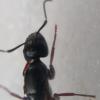
![]()
Camponotus ocreatus
Queen from 2019 now 200+ workers



誰でも大好き!well.....except a few
cocdeshijie’s Formicarium Guides: https://cocdeshijie....cfe2df393b517f7
Ants API: https://ants-api.qwq.xyz/
Novomessor cockerelli
Queen from August 2020, got 500+ workers in 6 months before I sold it to SleepyAsianAnter.


誰でも大好き!well.....except a few
cocdeshijie’s Formicarium Guides: https://cocdeshijie....cfe2df393b517f7
Ants API: https://ants-api.qwq.xyz/
Honestly though, it's a little weird in my opinion how few large colonies there are with alates. Off the top of my head, I can think of maybe 3-5 people on this forum with large mature colonies. A lot of people seem to leave after about a year or 2 too, judging from all the journals that were started and never updated past a few months or years. In discord too, many people are active for about a year and then disappear randomly.
I hear ya! It takes a fair chunk of time to care for our colonies. Some may think, ants, how hard can it be, only to get discouraged when tending issues arise and casualties occur.
As for alates, my smallest colony had one alate probably from an unfertilized egg but isn’t it unlikely for any of our colonies to replicate the conditions necessary to foster alates?
I mean, several people have gotten alates from captive colonies. Serafine has with his Camponotus barbaricus, ANTdrew has with like, 3 of his captive colonies. From what I can tell, it seems to be a matter of colony age and size, although not enough people have old, large ant colonies we can observe to see if it is just a matter of size and age in my opinion.
He travels, he seeks the p a r m e s a n.
My Camponotus parius colony is my only colony to survive from 2019.
The best colony i got would probably be either my Camponotus hyatti or my formica francoeuri. Both at around 40 workers and same age colonys and some of my first colonys ever. My Camponotus hyatti were bought from vern when he was moving out of state and are doing good now and are my 3rd colony I have ever kept. My formica francoeuri was caught here in nor cal and is y second colony I have ever kept. They aren't doing to well now. The queen won't lay any eggs and all they have is 8 pupae that are almost all workers. I think it's because they may have gotten sick of meal worms but they hollow out all of the meal worms. I don't know why the queen won't lay. ![]()
Honestly though, it's a little weird in my opinion how few large colonies there are with alates. Off the top of my head, I can think of maybe 3-5 people on this forum with large mature colonies. A lot of people seem to leave after about a year or 2 too, judging from all the journals that were started and never updated past a few months or years. In discord too, many people are active for about a year and then disappear randomly.
I can't speak for others, but after a few months of writing journals for several of my colonies, while not giving up on antkeeping, I stopped updating them and took a break from the forum. This was because the process of writing a journal entry with quality pictures took a long time for what began to feel like I was just reaffirming that my colony was alive and had grown. After some time feeling guilty that I wasn't writing enough, I chose to stop updating them altogether. Now that my Myrmecocystus mexicanus have begun to eclose full sized workers, I'm considering restarting their journal, but if I do I'm going to write in it less than before and focus on behavior and care rather than details, which I find more interesting. There are definitely plenty of people who give up on the hobby after a bit, but others just get tired of the process of journalling and/or leave the forum once they have an idea of how to care for their ants. As for my own colonies, I have one year old polygynous Brachymyrmex patagonicus colony that currently has male alates. They reside in a bifurcated Mini Hearth, with glass dirtied to the point that I can't get a remotely accurate estimate of their numbers, though I imagine it's somewhere between 500 and 1,000. Then again, they are an invasive species, small and very fast growing, so I wouldn't count that as much of an achievement. For my other colonies, all about the same age, my largest is certainly the Veromessor pergandei I bought at 15 workers from TheAntGuy nearly a year ago, now around 600 workers strong. They started out in a test tube, feeding entirely on a medium bag of Drew's seed mix (still 1/3 full), and eventually got large enough to move into a fallen fortress which they quickly grew into. They refused insect protein during founding, but recently I have found that they will consume it readily. Despite their limited diet, after a mediocre start, they exploded in population, though that seems to have slowed or stopped now that they fill their fortress. Here are some pictures of their nest and outworld. Notice their polymorphism - the larger workers are needed to open seeds, which they feed to their larvae in visible chunks. When I first got them, the queen was the only member of the colony large enough to do the job.
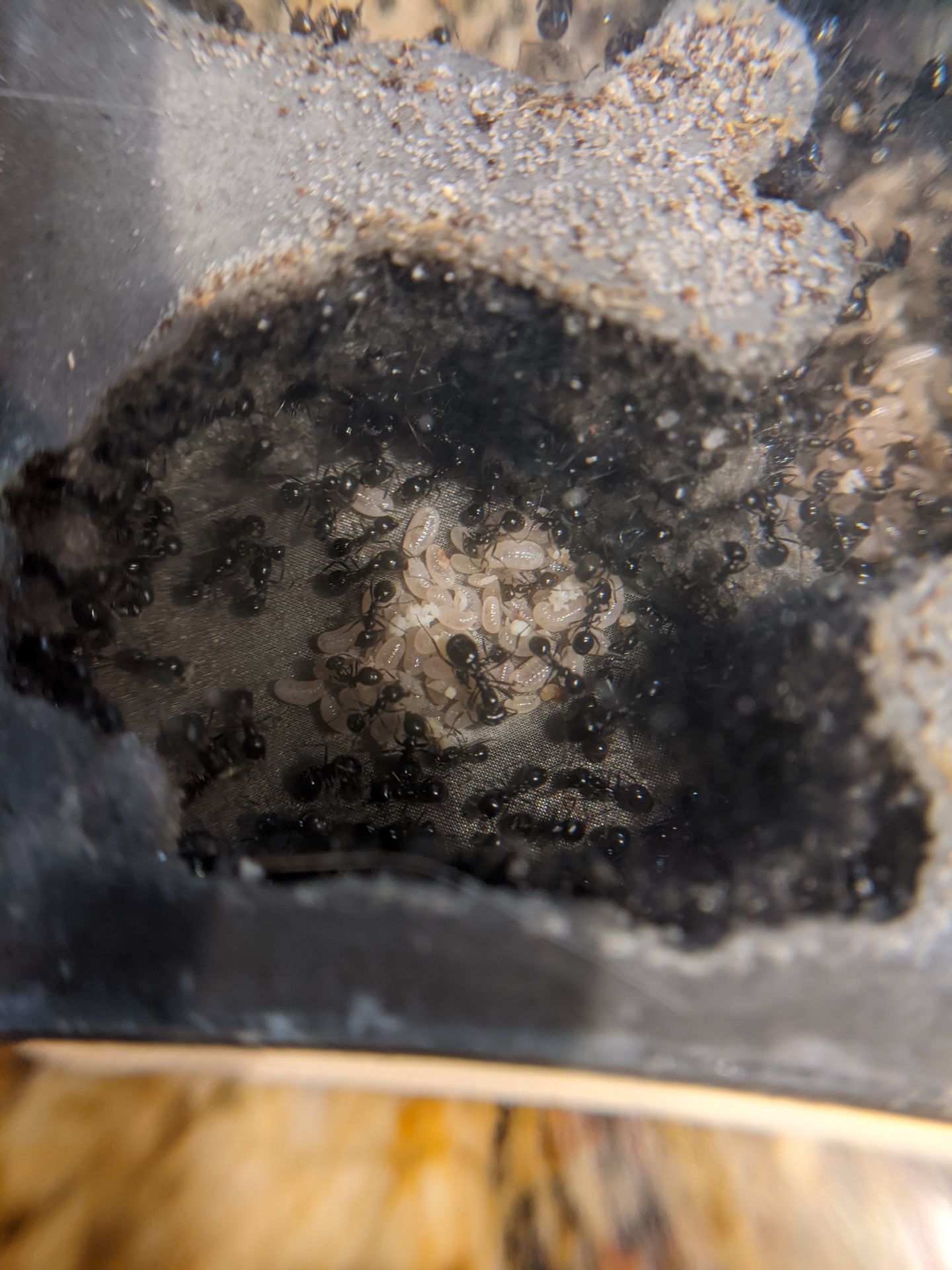
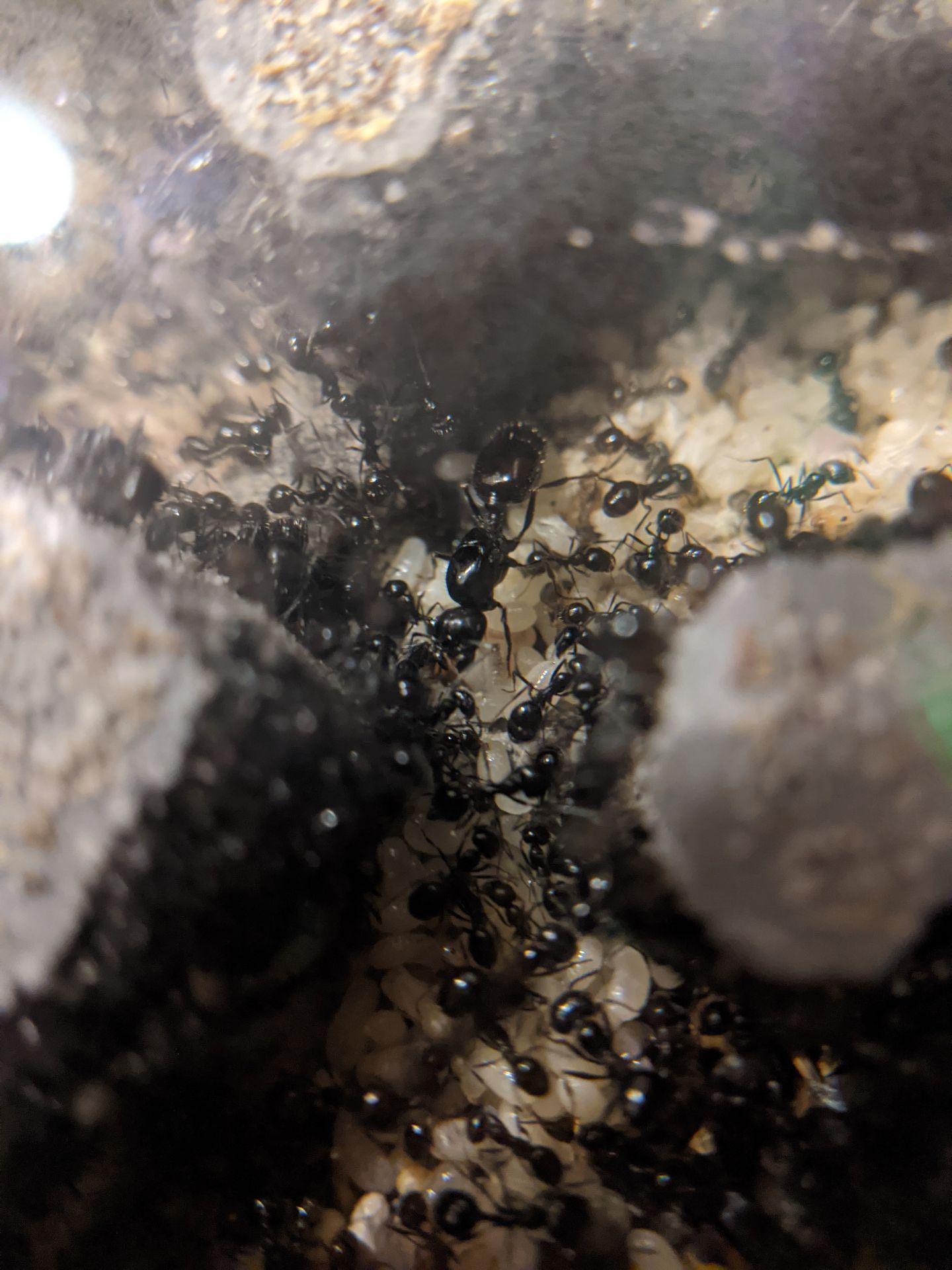
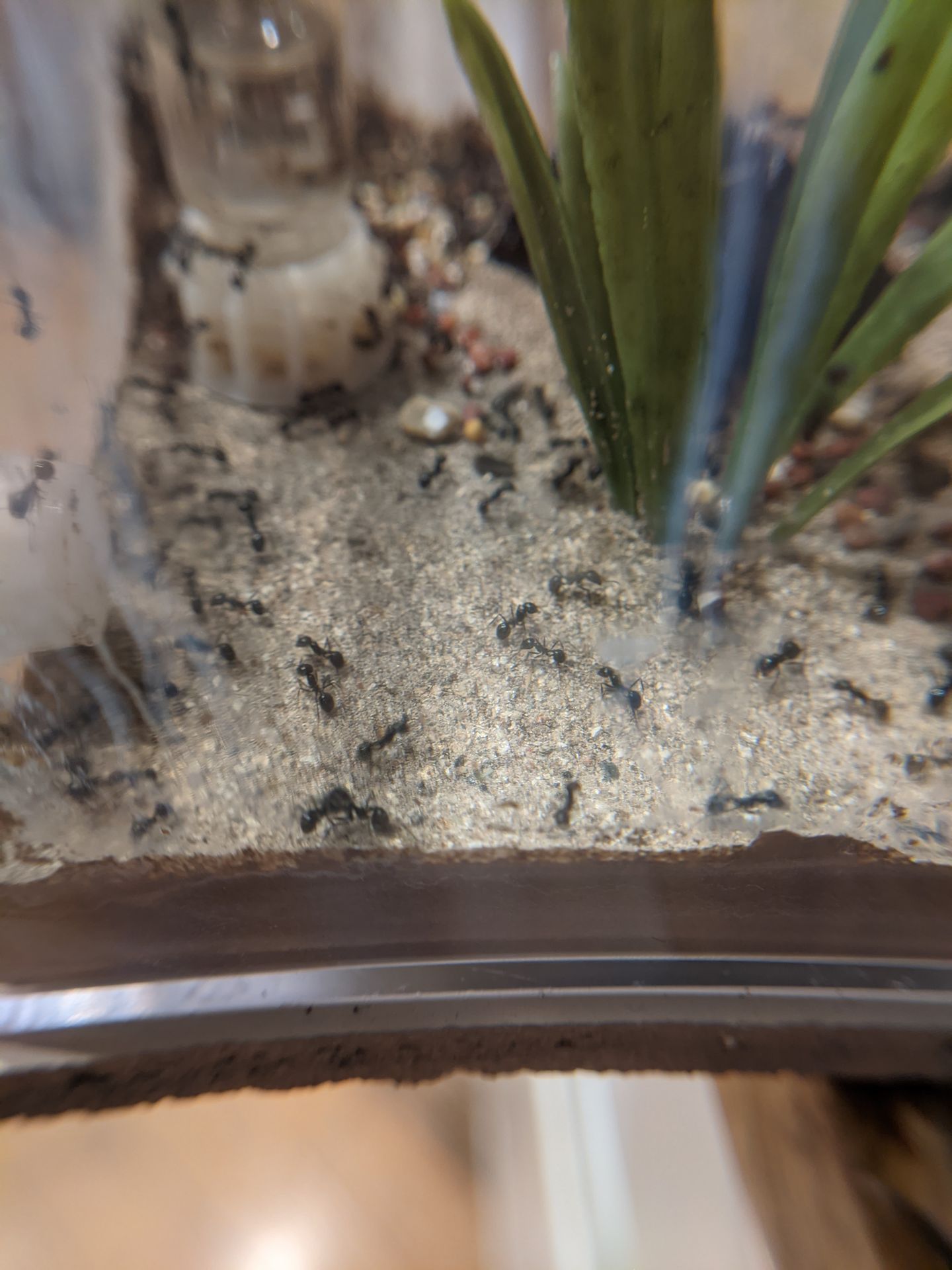
This colony of Crematogaster sp. I raised from a single queen, purchased without brood, to about 200 workers. Because I have recently kept them at room temperature, their colony has grown slower than my Veromessor, though when I get around to creating a larger hotbox I'm confident that their numbers will skyrocket similarly. They nevertheless inhabit a Labyrinth, my largest formicarium, and have two large brood piles consisting entirely of small-medium larvae. As they grew they moved from their test tube to a mini hearth, and then filled that up as well. At this point, I dropped their mini-hearth on the ground, the glass falling off and ants pouring across my floor. I seized the opportunity to move them into the Labyrinth as I had been planning, and after a painstaking night of using a paper to collect ants from my floor - I now have a mini-vac for that purpose - they were in their new nest. In the couple months since then, being unable to fit into my heated box, they have seen a slowing of movement and brood growth - a mini hibernation, though they still move and eat. Once I get them back on heating, they will fill up their nest, but for now they are still impressive. The first picture is their queen holding court. Like queen bee, she is constantly followed by an escort of workers to protect and tend. She will move around her nest daily, and is unfailingly followed by these attendants. During the chaos of the move to the Labyrinth, workers covered her completely as she walked, making her appear almost as a moving ball of ants. The second is a picture of one of the colony's brood piles - note the completely uniform size.
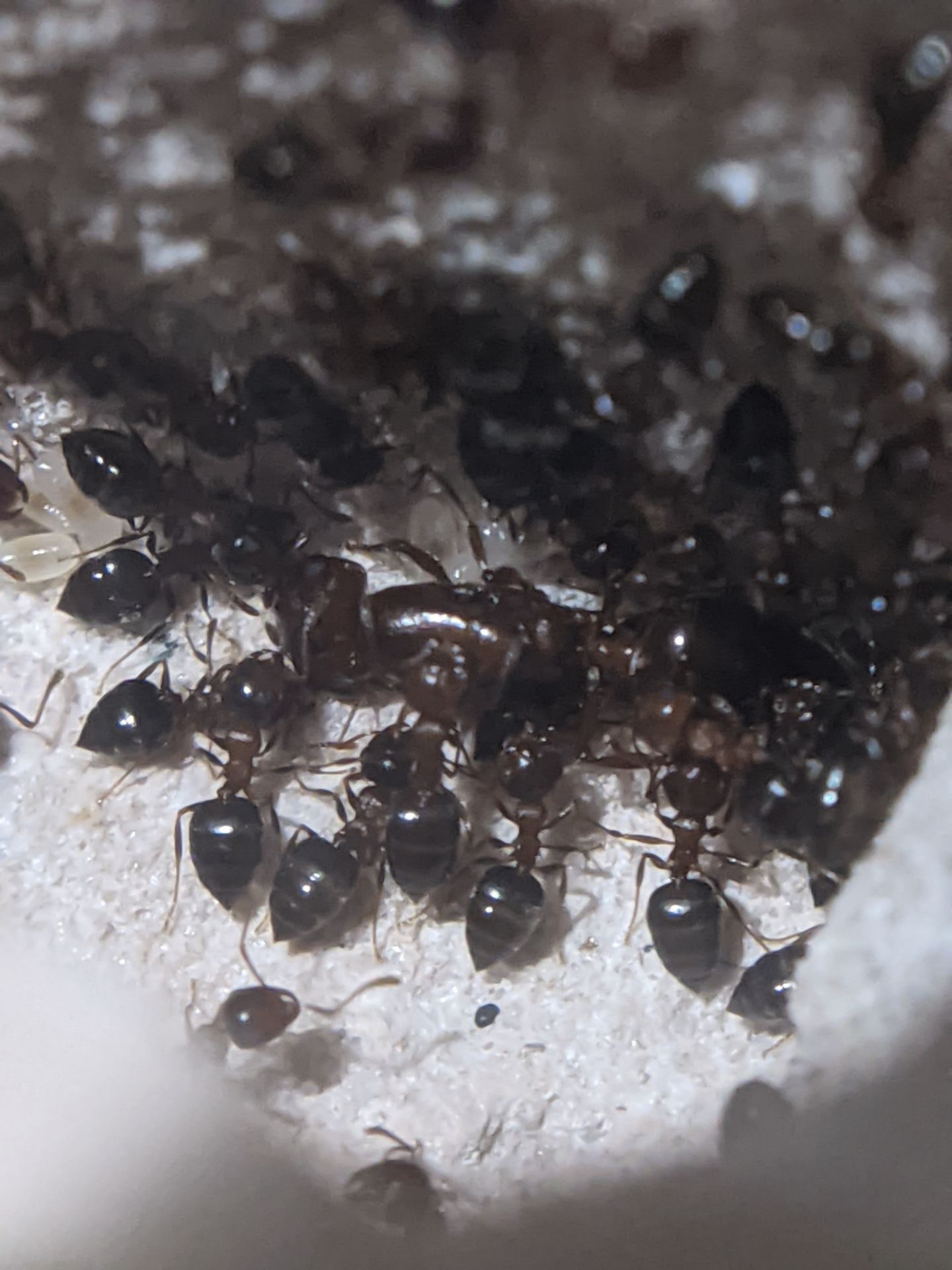
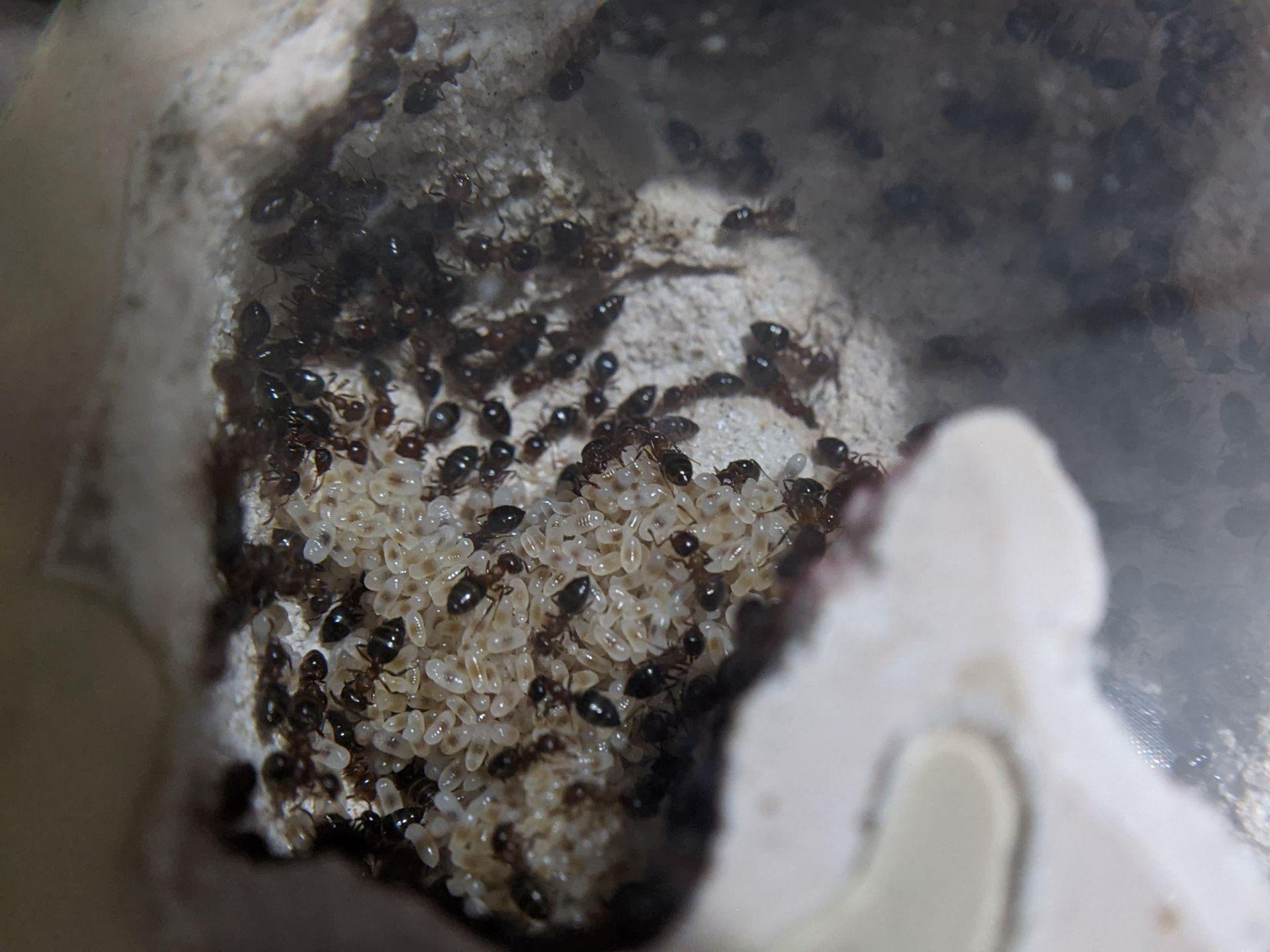
Edited by TestSubjectOne, July 7 2021 - 12:00 AM.
TestSubjectOne's Experiences in Antkeeping General Journal
Currently Keeping:
- Veromessor pergandei (1 queen, 600 workers)
- Novomessor cockerelli (1 queen, 200 workers)
- Myrmecocystus mexicanus (1 queen, 100 workers)
- Brachymyrmex patagonicus (3 queens?, 2,000 workers? & alates)
- Crematogaster sp. (1 queen, 600 workers)
- Liometopum occidentale (1 queen, 800 workers)
- Camponotus absqualator (1 queen, 130 workers)
Honestly though, it's a little weird in my opinion how few large colonies there are with alates. Off the top of my head, I can think of maybe 3-5 people on this forum with large mature colonies. A lot of people seem to leave after about a year or 2 too, judging from all the journals that were started and never updated past a few months or years. In discord too, many people are active for about a year and then disappear randomly.
I can't speak for others, but after a few months of writing journals for several of my colonies, while not giving up on antkeeping, I stopped updating them and took a break from the forum. This was because the process of writing a journal entry with quality pictures took a long time for what began to feel like I was just reaffirming that my colony was alive and had grown. After some time feeling guilty that I wasn't writing enough, I chose to stop updating them altogether. Now that my Myrmecocystus mexicanus have begun to eclose full sized workers, I'm considering restarting their journal, but if I do I'm going to write in it less than before and focus on behavior and care rather than details, which I find more interesting. There are definitely plenty of people who give up on the hobby after a bit, but others just get tired of the process of journalling and/or leave the forum once they have an idea of how to care for their ants.
Who knows, maybe there are actually a ton of people with big, old colonies just off the internet. I kind of doubt it honestly, and think people might've just lost interest before their colonies got big.
Edited by DDD101DDD, July 7 2021 - 7:43 AM.
He travels, he seeks the p a r m e s a n.
Not to highjack the thread but, TestSubjectOne, you make a great point! Good documentation in itself can be a demanding task. Perhaps worthy of its own thread. I’ve not gone the blog or journal route but I both enjoy and appreciate the Massachusetts thread. Occasional updates, questions and answers. Information for the knowledgeable and pearls for the newcomers.
Edited by Canadant, July 15 2021 - 3:40 PM.
My most successful, by far, is my Camponotus Discolor colony which started as a queen and about 20 workers. These girls now have close to 300 and have a respectable pile of brood. They scout their entire enclosure, explore every facet, once in awhile one of them somehow gets up on the lid of the tank (I need to address that probably tonight, before it becomes an issue. I have their enclosure "surrounded" with houseplants so if they DO plot an escape, it will likely be into one of these potted plants again). But yeah, they are awesome to watch, LOVING honey, crickets, mealworms and June Bugs. I might actually look up how to raise June bugs as feeders...)
My Trachymyrmex colony is impossible to count but still are going strong. They have at least the same number of ants as when I got them, and I assume they have grown in number but again, it's hard to tell since so many of them process food for the fungus AND tend the fungus underground.
The other three are... Challenges? THey haven't died off yet (thankfully) but are in different phases of very small growth. Camponotus Nova, Camponotus Chromiodes and Formica Subsicera.
This is a GREAT thread, and I plan to watch it closely.
My Atta: https://www.formicul...ted-729/page-12
When I got them they were nearly dead; or at least the fungus was. They had *maybe* a teaspoon of fungus when they should've had at least half a cup. Then a few months later I accidentally almost killed them again when I fed them some roses that had a fungicide. In the 5 months since that incident they've gone from just a few hundred workers to tens of thousands and probably 2+ liters of fungus.
(not to mention being possibly the most popular formiculture journal? which is awesome?)
I like leafcutter ants. Watch The Ultimate Guide to Fungus Growing Ants:
https://youtu.be/VBH...4GkxujxMETFPt8U
This video took like over 100 hours of work, you should for sure watch it.
I'm making this to list your most sucessful colonies/queens(and to test a theory of ANTdrews)
my older cousin who got me into anting had a colony of myrmecocystus with alates
What i am keeping Brachymyrmex patagonicus 1 worker x5 tetramorium immigrans 10 workers x2 lasius crypticus 5 workers Pheidole californica 6 queens150~ workers 10-30 majors, Formica argentea 10~ W
What I've kept crematogaster sp pheidole californica camponotus vicinus high elev, dumetorum,laevigatus, prenolepis imparis, pogonomyrmex californicus and subnitidus and californicus, veromessor andrei, camponotus sayi, hypoponera opacior ,Liometopum occidentale solnopsis molesta group, solenopsis xyloni.
Oh that's nice who's your cousin? I've also never heard of someone that has a colony of Myrmecosytus with alatesmy older cousin who got me into anting had a colony of myrmecocystus with alatesI'm making this to list your most sucessful colonies/queens(and to test a theory of ANTdrews)
Ant Shop: (restocking soon) https://www.formicul...op/#entry195574 ![]()
0 members, 1 guests, 0 anonymous users